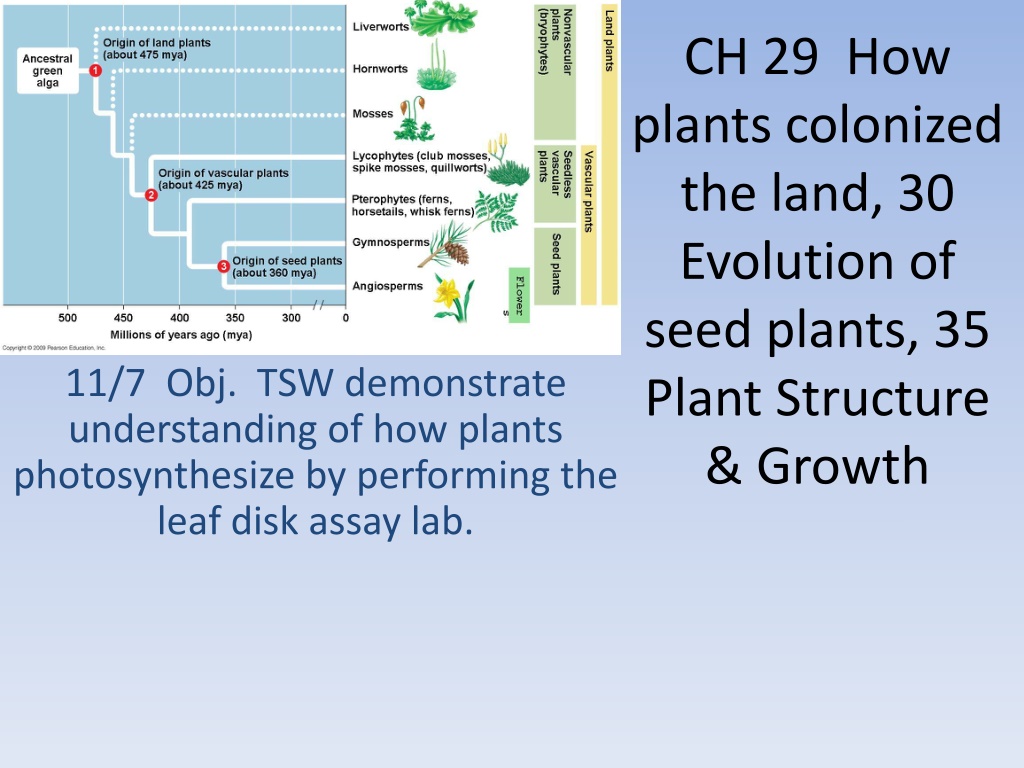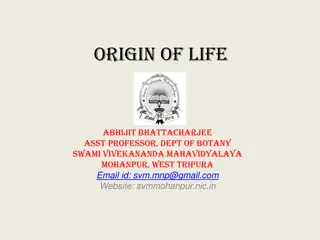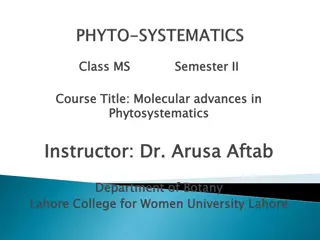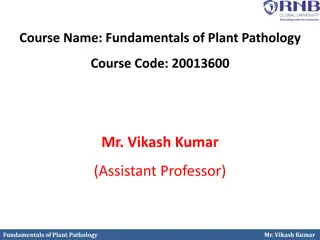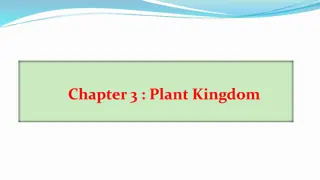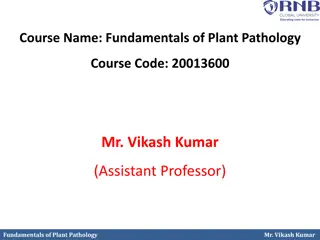Understanding Plant Evolution and Characteristics
Plants colonized land through various adaptations such as multicellularity and photosynthesis. They exhibit characteristics like chlorophyll, cellulose cell walls, and apical meristems. Plant evolution includes alternation of generations, with gametophytes and sporophytes undergoing meiosis and mitosis to reproduce. Four main groups of land plants are bryophytes, pteridophytes, gymnosperms, and angiosperms, each with unique reproductive and vascular features.
Download Presentation

Please find below an Image/Link to download the presentation.
The content on the website is provided AS IS for your information and personal use only. It may not be sold, licensed, or shared on other websites without obtaining consent from the author. Download presentation by click this link. If you encounter any issues during the download, it is possible that the publisher has removed the file from their server.
E N D
Presentation Transcript
CH 29 How plants colonized the land, 30 Evolution of seed plants, 35 Plant Structure & Growth 11/7 Obj. TSW demonstrate understanding of how plants photosynthesize by performing the leaf disk assay lab.
Plant characteristics Multicellular, eukaryotic, photosynthetic autotrophs, cells walls cellulose and Chlorophylls a & b, monophyletic Charophyceans- closest algal relative to plant kingdom, inhabited shallow waters around edges of ponds and subject to occasional drying Homologous chloroplasts Cellulose microfibrils of cell walls Enzymes peroxisomes (associated with chloroplasts Flagellated sperm cells Cell division formation of cell plate (phramoplasts) Ribosomal RNA & chloroplast DNA connect Charophyceans to plants Apical Meristems localized regions of cell division at the tips of shoots and roots Multicellular dependent embryos derived characteristics to land plants
Alternation of generation: Gametophyte (haploid) & sporophytes (diploid) Meiosis in the sporophytes produces haploid reproductive cells spores Spore can develop into a new organism (gametophyte) w/o fusing with a another cell Mitotic division of the spore produces a new multicellular gametophyte that produces gametes that unite to form the zygote that develop into a sporophyte
Four main groups of land plants: Bryophytes, Pteridophytes, gymnosperms, Angiosperms, (10 plant phyla) Bryophytes mosses, liverworts, hornworts Have reproductive adaptations different from algae Offspring develop from multicellular embryos that remain attached to the mother plant, which protects and nourishes the embryo. Lack vascular tissue, but do have water conducting tubes No true roots, stems or leaves Dominant generation: gametophyte form Dispersal of spores by wind
Pteridophytes Lycophytes (Club Moss), Pterophyta (ferns, whisk ferns, horse tails) Vascular tissue, but no seeds Cells are honed into tubes that transport water and nutrient throughout the plant body Xylem transport water Phloem transports sugar Sporophyte generation dominant form
Gymnosperms- naked seed (Conifers) Vascular and seeds (facilitating reproduction on land), cone bearing 360 million years ago Sporophyte generation dominant form Transfer of pollen to the ovule Pollination 4 Phyla of gymnosperms Ginko-fan-like leaves, deciduous Cycads- resemble palms Gnetphytes- shrub-like Conifers pine trees, redwood
Angiosperms Vascular, seeds and flowering plants 130 million years ago Protective coat and ovary around seed- fruit (protects the seed, helps it get eaten and carried to a different place to decrease competition with parent plant Sporophyte generation dominant form Monocots(one cotyledon - corn), Dicots (two cotyledon - bean) Coevolution Angiosperms & animals Flying insects pollination (creates diversity of flowers) Agriculture fruit & vegetable crops: corn, rice, wheat (selective breeding- artificial selection) Sustainability plant diversity nonrenewable resource, extinction of plant species and animals that depend on them Available medicines Available resources housing Economy- jobs - balance http://ts1.mm.bing.net/images/thumbnail.aspx?q=1327001830820id=755569ccabeaf6bb05da15e0a581dcb7
Complete Flower http://ts1.mm.bing.net/images/thumbnail.aspx?q=1327001830820id=755569ccabeaf6bb05da15e0a581dcb7
Plant structure & growth Roots, Stems Leaves - organs Hierarchy of structural levels: multicellular organism, consisting of organs composed of tissues, with different types of cells Monocots fibrous root system Dicots taproot Root hairs- increases the surface area to absorb water and minerals and anchor the plant Stems have nodes give rise to leaves Leaves main photosynthetic organ
Plant organs: 3 tissues- dermal, vascular & ground Dermal epidermis, single layer of tightly packed cells that covers & protects all young parts of the plant. Also have specialized characteristics consistent with the function Ex. Leaves cuticle (waxy) to reduce water loss Roots root hairs, to increase water absorbtion Vascular Xylem moves water and dissolved minerals upward Phloem transports food made in leaves to roots and developing leaves and fruits. Ground Photosynthesis, storage, and support Pith- internal to vascular tissue Cortex external to the vascular tissue
Plant Cells Xylem- Tracheids water transport Vessel element transports water, but the cell itself is dead at maturity Phloem - Sieve- tube members -Sucrose transportation Lack a nucleus, ribosomes, and distinct vacuole Sieve plates end walls between sieve tube members Companion Cell along side the sieve tube member, help load sugar produced in the leaf. It does have a nucleus and ribosomes that serve the adjacent sieve-tube member. Parenchyma typical plant cell, not specialized, primary walls, thin and flexible, large central vacuole. It performs metabolic functions for the plant (photosynthesis) Collenchyma thicker primary walls, uneven, help support young parts of the plant (celery stalk), provide support Sclerenchyma occur in regions of the plant that have stopped growing, thick secondary wall, do not elongate
Alternation of Generations P. 27 With the following cards, place them in order and write the order in your notebook. You have three minutes GO! Meiosis, Mitosis, Gamete, Spore, Fertilization, Sporophyte, Gametophyte, Zygote P. 611 Life cycle of an Angiosperm Sporophyte (2n) meiosis spore (2n) gametophyte (n) gametes (n) fertilization zygote mitosis Sporophyte
Word Association- Say the scientific name Pine cone Flower Moss Fern Vascular/seeds/no flowers Nonvascular Vascular /Seedless Vascular/seeds/ flowers Double fertilization Finish Your test I am grading it Thursday!
Bloody Chlorophyll Why does the chlorophyll look red? We extracted the chlorophyll from the membrane. The electrons still get excited when light shines on the molecule and move up in energy state. However, they don t have anywhere to go since they are not embedded in the membrane and don t have an electron transport chain to be passed off to. So the electrons fall back down to a lower energy level and the excess energy is emitted as red light.
Leaf Disk Assay Lab (if the row does not add up to 10, the disk did not rise) 5 min 10 min 15 min 30 min 45 min 60 min 90 min 2 hours 0 Bicarbonate 0 0 0 0 0 0 0 0 .5 tsp Bicarbonate 0 0 0 1 2 3 1 0 1 tsp bicarbonate 0 0 0 2 2 4 2 0 2 tsp bicarbonate 0 1 1 5 1 1 0 1
